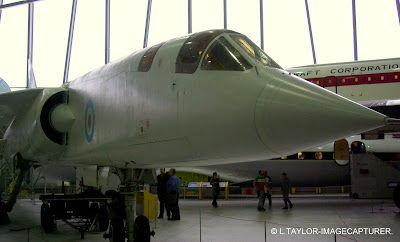CURTISS P-40C TOMAHAWK.
Single engine single seat fighter and ground attack aircraft produced by the US American manufacturer Curtiss-Wright airplane company. P-40s in service with the British commonwealth and the Soviet Forces were called Tomahawk ( P-40B, P-40C ) and Kitty Hawk ( other variants ).
This aircraft sent to the Soviet Union as part of the lend-lease program. This P-40C was finished as P-40 39-159 which was used by the technical training command at Chanute Field, Illinois, USA in 1940. This aircraft 41-13357 is one of two P-40C acquired from the former Soviet Union in the 1990s by the fighter collection and was in much worse shape than the other 41-13390. During the restoration it was decided to finish the aircraft in the Technical Training Command School scheme of a P-40 based at Chanute Field, Kansas. This aircraft wears the scheme of 39-159, a P-40C that was stripped of its olive drab camouflage paint and used as a personal hack, for base commanders. The badge on the side of the aircraft `Sustineo Alas` translates as `Keep them flying` and was applied to most of the training aircraft at Chanute Field. Crew - one. Engine- one 1040hp Allison V-1710-33. Armament - six 50 cal wing mounted machine guns, max 1,500lbs of bombs on three wing hardpoints. Max speed - 345mph. Service ceiling - 28,871ft. Range - 1,230 miles.
~~~~<<<<>>>>~~~~
TSR2.
British Aircraft Corporation TSR2. Prototype strike aircraft designed to replace the Canberra Bomber in the 1960s. TSR2 stands for Tactical, Strike, Reconnaissance ( Mach 2 ). The project was cancelled in 1965 because of rising costs.
~~~~<<<<>>>>~~~~
FAIRCHILD - REPUBLIC A-10A THUNDERBOLT 11 WARTHOG.
This low flying ground attack aircraft was created to destroy Soviet Tanks during the cold war. US experiences in the Vietnam war suggested the need for a new, tough ground attack aircraft. America also needed an aircraft which could attack and destroy Soviet Tanks in Europe. Powerful and accurate weapons, plus the ability to withstand fire from the ground, were considered more important than speed. The A10 was designed to meet these requirements. Officially known as the Thunderbolt 11, it was more often referred to as the Warthog. The first 713 A-10s became operational with the USAF in 1976. Some A-10s were based in Britain at RAF Bentwaters and RAF Woodbridge in Suffolk. During the Gulf war, 144 A-10s deployed from these bases to Saudi Arabia. Since then, they have been used in conflicts in Bosnia, Kosovo, Afghanistan, Iraq and Libya. In 2014 they began flying missions against Isis in Iraq. This aircraft ( 77-0259 ) was assigned to United States Air Forces in Europe ( USAFE ) from 1979 to 1981 and from 1990 to 1992. In the US it served with both Wisconsin and Pennsylvania Air National Guard Units, and in the UK was based at RAF Bentwaters and later at RAF Alconbury.
~~~~<<<<>>>>~~~~
WESTLAND WASP HAS1.
Light Royal Navy anti-submarine helicopter, designed to operate from small ships. Wasps served in the Falklands War in 1982. The Wasp was the naval version of the British Armys Scout helicopter. It was compact, light and could operate from the small hanger and flight deck on board anti-submarine frigates and other small vessels. It could carry torpedoes, depth charges or missiles, but it was too small to carry submarine detection equipment as well. It was guided to the target by its ship. By the time of the Falklands War, Wasps had been in service for over twenty years. They were gradually being replaced by Lynx helicopters. However a number of ships were still equipped with the type. These included HMS Antrim, Brilliant, Plymouth and Endurance. In April 1982 Wasps from several Royal Navy ships attacked and disabled the Argentine submarine Santa FE. Wasps also carried out casualty evacuation missions and gunnery observation duties. This aircraft, XS567, entered service in 1964. It flew from HMS Apollo, which was part of the task force but did not sail for the Falklands until 18th June. It was retired from service in 1986. Crew-two-pilot and observer. Engine-one Rolls Royce Nimbus 103 or 104 turbine engine of 710hp. Weapons-two MK44 or one MK46 torpedo or depth charges. Max speed - 120mph. Service ceiling - 12,200 ft. Range-303 miles.
~~~~<<<<>>>>~~~~
UH-1H IROQUOIS HUEY.
This helicopter carried troops into battle, lifted wounded men out of combat and also attacked targets on the ground. Crew-two. Engine-one 1,044kw Lycoming TS3 -L-138 Turboshaft. Armament- in the troop transport role, two side door machine guns were carried. Top speed - 138mph. Cruise speed- 126mph. Service ceiling - 12,500feet. Range- 253miles.
~~~~<<<<>>>>~~~~
BRITISH AIRCRAFT CORPORATION ONE-ELEVEN 510.
The one-eleven was the first British short-haul Jet Airliner. Engines-two 12,000lbs thrust Rolls Royce Spey 511-14D Turbofans. Max speed-541mph. Range-2,165miles. Ceiling-35,000feet. Crew-two. Passengers-97-109.
~~~~<<<<>>>>~~~~
HAWKER SIDDELEY TRIDENT 2E.
A medium range airliner in service with British European Airways ( BEA ) and British Airways ( BA ) from 1964 to 1980s.
~~~~<<<<>>>>~~~~








OK. This is cool! The Tomahawk is well known. Now that TSR2 is a new one for me. Awesome looking with some meanness mixed in. Looks like it could do well. That Warthog could get the job done! Highly feared by tankers and such on the wrong side of things. Those things are definitely tank eaters! Both of those airliners look sleek and reliable. That chopper Wasp has a certain look to it. Guess it might not be a good idea to have it looking for you. Might just find ya. Now here is the venerable Huey. I rode in many, many of those in the Marines. Good, reliable workhouse. They also had a twin engine version as well. Got some good machines here, Les!
ReplyDelete